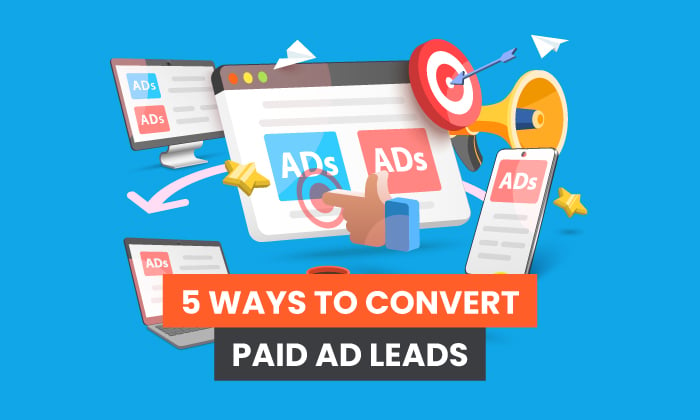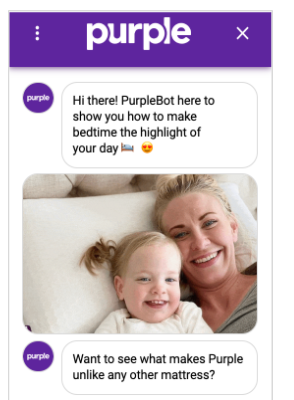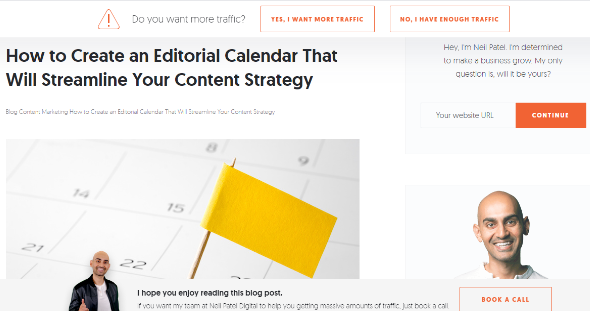
As it becomes increasingly challenging to grow organic reach, more and more marketers are looking to paid ads.
Since this monetary model is by no means novel, that means there’s a crowded space for these ads. You want to ensure your dollars dedicated to pay-per-click (PPC) are getting their money’s worth.
Maybe you’ve written scintillating paid ad copy that speaks directly to your audience’s pain points. Maybe you’ve drafted a graphic that is the perfect balance between branding and intriguing. Maybe you’ve set your budget and ad parameters and are ready to go.
How do you get those paid ad leads to actually convert?
This, of course, is the challenge of paid marketing. You can do nearly everything right, but without clear direction for your audience to further interact with your paid ads, you’ve done little more than create a pretty picture.
To help you make the most from your paid ad dollars, we dive into the five best methods for converting paid ad leads.
5 Methods to Convert Paid Ad Leads
While the term conversion can conjure different meanings to different marketers, for the purpose of this post, we’re defining conversion as any desired action, whether that be purchase, form-fill, email capture, or simply a learn-more action.
Regardless of your current working definition of conversion, the following methods can help your paid ads convert, enabling you to reach your marketing goals.
Below, we break down five tried-and-true methods that can help your paid ads translate to valuable conversions.
1. Route Leads to a Chatbot or Messenger
As technological capabilities evolve, so do our strategies for lead conversion. As artificial intelligence (AI) continues to advance, increasing opportunities for chatbots arise.
In fact, it’s projected that chatbots will manage 85 percent of customer interactions in the near future.
These days, chatbots are built into many websites. Visit nearly any site, and you’ll be greeted by an automatically generated message asking you what you’re searching for and how the bot can help.
In addition to simply operating as a help feature, chatbots can be used as a tool to improve site visitor experience, not to mention completely changing the way brands communicate and interact with their existing and would-be consumers.
Since chatbots are infinitely customizable and can provide personalized responses, how consumers interact with your brand has changed drastically.
With successful chatbot addition to your marketing strategy, you can improve your customer’s journey through increased personalization and drive conversions through an interactive platform.
How can you incorporate chatbots into your paid ad strategy?
It’s easy: Instead of sending an individual who clicks on your paid ads to a classic web form, direct them to a chatbot. There, they can engage in a personalized, targeted conversation that can lead to the conversion you’re aiming for.
While simply having a chatbot is a great strategy to increase paid ad conversions, writing good copy for the bot can make a good strategy great.
Here are our top three tips for successful chatbot copywriting:
- Sound conversational: Chatbots are not the time to flex your vocabulary. In fact, messages written at a third-grade level receive 36 percent more responses. Using simple and clear language is key.
- Have a cohesive tone: Choosing the right voice for your chatbot depends on the tone of your business. Whether you’re fun or formal, be sure to mimic that style as you develop your chatbot’s responses.
- Use a catching hook: You want your site visitors to interact with your bot. To ensure this interaction happens, use a compelling hook to catch their interest. Check out this example from Purple, a mattress company that excels at snagging attention through an emotional pull.

2. Direct Leads to a Landing Page
Historically, paid ads drive to landing pages, and this isn’t a bad thing.
The trouble with landing pages occurs when they’re not optimized properly. You may have the most compelling paid ads on the web, but if your landing pack is lackluster, your conversion rates will be, too.
Below, we share our top five tips for making your landing pages work as hard as you do:
- Research user behavior: If you don’t understand how users interact with your page, it’s hard to understand what is and isn’t working. You can employ free tools that build a heat map on your pages, letting you better understand what your users are doing so you can tailor the layout to meet their movements.
- Identify pain points: Be sure to create copy that indicates you have a clear understanding of your audience’s problem—not to mention a clear, simple solution. When you lead with pain points, you’re that much more likely to intrigue your audience, getting them to sign up for that demo or join your email list.
- Provide value: Without fail, your landing page should offer some carrot to your audience. Whether that’s a whitepaper or a video, a webinar or a podcast, make sure your landing page offers your audience something they’ll find valuable (and find easily on your page).
- A/B test: Test everything. We mean it. Anything you can track the performance of, track it. The more data you have about how specific elements on your page are performing, the more likely you are to get very close to the ideal set of on-page elements that lead to conversion.
- Remove distractions: Less is more when it comes to your landing pages. Have a lot of great content? Good. Hold onto it—now is not the time to use it. As you build your landing pages for paid ads, be selective in what you include. There’s a singular action you want your site visitors to take. Don’t confuse that message by overburdening your page.
3. Direct Leads to Forms on Social Media
Another way to increase conversions from your paid ads leads is to drive direct leads to forms on social media. With 83 percent of marketers using social platforms to advertise, there are a lot of paid ads appearing on social.
How do you get your paid ads to translate into a conversion on social platforms?
By following best practices. Let’s take Facebook, for example. The social media giant reports over 2.7 billion active users per month. With that many active users, you know there’s a plethora of marketers.
To make your paid ads stand out in the crowd and actually convert, you can build forms into your paid ads on the platform. That way, users don’t have to navigate away from their social scrolling to, say, sign up for your newsletter.
To drive even more conversions via forms on social media, consider using these two best practices for incentivizing:
- Share a discount code: Everyone loves a discount. To increase your paid ads conversions through forms on social, try offering audience members who take your desired action a unique discount code. This way, you’re not only converting, but you’re also building goodwill with your audience.
- Host a competition: If offering a discount code doesn’t apply to your product or will reduce the perceived value, host a competition.
Both of these strategies allow you to deliver value to your audience while still achieving your conversion goals.
4. Route Customers to a Purchase Page
If your aim is conversions from paid ads, drive customers to a purchase page. This strategy is highly effective, as it considerably shortens the buyer’s journey, taking an individual directly from interest to purchase. By eliminating steps in between these two phases, you dramatically increase the likelihood that your ad will convert.
Clothing line Hello Molly uses Instagram paid ads to advertise its garments. If users click on one of the images, they’re taken directly to the purchase page for that item.
By driving directly to the page, you shorten the number of steps your potential customer has to take to convert.
What’s more, the consumer doesn’t need to leave the confines of Instagram. The entire sales process occurs in the app.
5. Direct Leads to Your Blog
While, at times, blogging may feel like a technique of the past, your blog should still play a vital role in your content marketing strategy.
In fact, blogs continue to outrank emails, books, and whitepapers as the most effective type of content, and if you’re not driving your paid ad leads to your blog, you may be missing out on a slew of conversions. After all, your blog is a hub of content that speaks to pain points and fills in knowledge gaps within your industry.
If your conversions are focused on asset downloads, you should definitely drive traffic from paid ads directly to relevant components on your blog.

How to Know Which Method Is Right for You
Feeling overwhelmed by these five options? Don’t be! Knowing which method is right for you is all about understanding the true goal of your overall ad campaign.
- Determine your conversion goals
Think about what action you want your leads to take. Do you want their email address so you can send them your newsletter? Do you want them to download resources you publish? Do you want them to make a purchase? These are common conversion goals, though yours may be something else entirely.
- Decide where you want to direct users who click your ad
You will most likely direct your users to a landing page, purchasing page, or a lead generation form.
- Decide which method is best for you
Map out your goals with the strategies listed above and decide which will be most helpful for you to reach your goals.
For example, if you’re hoping to increase whitepaper downloads, consider linking to a synopsis blog that includes a download option of the entire paper.
If your goal is to increase purchases you should definitely drive your leads from paid ads directly to product pages.
Paid Ad Conversions FAQs
If you’re still not sure about how to convert paid ad leads, here are a few commonly asked questions to help guide you:
To drive your paid ad leads toward conversion, be sure to align their destination with your conversion goal. If you’re looking to drive purchases, consider directing leads to a purchase page. If you’re looking to drive whitepaper downloads, drive to a blog. Regardless of the goal, be sure to send your leads to a location where they can take clear and direct action.
Incorporating chatbots into your paid ad strategy is simple and can result in increased conversions given the endless possibilities of this conversational tool. Instead of sending an individual who clicks on your paid ads to a classic web form, direct them to a chatbot. There, they can engage in a personalized, targeted conversation that can lead to the conversion you’re aiming for.
Regardless of your conversion goal, be sure that the location you’re driving leads to that goal. When conversion and destination are aligned, the conversion process is compressed, making it easier than ever to achieve your conversion dreams.
Here are five keys for website optimization: A/B test, prove value, address pain points, remove distractions, and research user behavior.
Conclusion for Paid Ad Conversions
As the use of paid ads becomes increasingly ubiquitous, driving consumers to the right location to convert becomes even more important than ever before.
Clear direction is always important for online consumers, but it’s never more important than in the steps that lead to conversion. By having a clear and direct goal for your paid ads and aligning that goal with a landing location that correlates, your potential customers are that much more likely to become consumers.
When you pair the right content with the right process, you unlock the door to successfully converting paid ad leads.
If you decide you want to employ these strategies yourself even though you think they may be beneficial, let our agency know. We can handle the heavy lifting for you.
What’s the most successful conversion path for leads from paid ads that you’ve used?
from Blog – Neil Patel https://ift.tt/3zwhWbp
via IFTTT
No comments:
Post a Comment